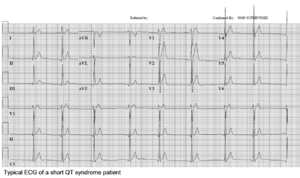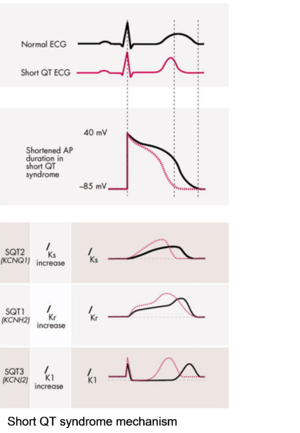SQTS: Difference between revisions
(Created page with "There is controversy whether short QT intervals are associated with sudden death. One trial found QTc intervals < 300ms to be associated with sudden death.<cite>Gaita</cite> Howe...") |
No edit summary |
||
| Line 1: | Line 1: | ||
<i>Auteur: Louise R.A. Olde Nordkamp</i> | |||
[[ | <i>Supervisor: Arthur A.M. Wilde</i> | ||
The '''short QT syndrome''' is a very rare syndrome characterized by an abnormally short QT interval and increased risk of ventricular fibrillation and cardiac death. | |||
==Clinical diagnosis== | |||
[[Image:ShortQT_syndrome_patient.png|thumb|right]] | |||
The diagnosis is based on the presence a short QT interval, in which the upper limit is mostly set on 330 ms. Males are more often affected than women. A history of cardiac arrest is present in one-third. Patients are at risk for both atrial arrhythmias (AF) and ventricular arrhythmias (VT/VF). | |||
==Physical examination== | |||
Patients can present with symptoms of arrhythmias: | |||
*Out-of-hospital-cardiac-arrest | |||
*Syncope, pre-syncope (weakness, lightheadedness, dizziness) | |||
==ECG tests== | |||
[[Image:Bazett.png|thumb|left]] | |||
The ECG demonstrates a corrected QT interval significantly below the limit of normal (<330 ms). Additionally, notable ECG findings are the presence of a sharp T-wave beginning at the end of the QRS complex, preceded by a brief or absent ST-segment. Exercise electrocardiographic studies in SQTS patients also characteristically reveal a non-physiologic lack of QT shortening at increased heart rates. | |||
==Genetic diagnosis== | |||
[[Image:ShortQT_syndrome_mechanism.png|thumb|left]] | |||
In a quarter of the patients a mutation is found, predominantly in the KCNH2 gene (SQTS1). This gain-of-function mutation causes an increase in the potassium efflux and, subsequently, to a decrease of the myocyte refractory period. Mutations in the KCNQ1, KCNJ2 and possibly CACNxxx genes are also associated with the SQTS. | |||
==Risk Stratification== | |||
Risk stratification in SQTS is still ill-defined and should be done by a specialized cardio-genetic cardiologist. | |||
==Treatment== | |||
Hydroquinidine is suggested for normalization of the QT interval in patients with a KCNH2 mutation. ICD therapy is advised in SQTS patients for secondary prevention of sudden cardiac death and could be considered | |||
== References == | == References == | ||
<biblio> | <biblio> | ||
# | #Giustetto pmid=16926178 | ||
#Giustetto2 pmid=21798421 | |||
# | #Patel pmid=20716721 | ||
# | |||
</biblio> | </biblio> | ||
Revision as of 01:44, 25 March 2013
Auteur: Louise R.A. Olde Nordkamp Supervisor: Arthur A.M. Wilde
The short QT syndrome is a very rare syndrome characterized by an abnormally short QT interval and increased risk of ventricular fibrillation and cardiac death.
Clinical diagnosis
The diagnosis is based on the presence a short QT interval, in which the upper limit is mostly set on 330 ms. Males are more often affected than women. A history of cardiac arrest is present in one-third. Patients are at risk for both atrial arrhythmias (AF) and ventricular arrhythmias (VT/VF).
Physical examination
Patients can present with symptoms of arrhythmias:
- Out-of-hospital-cardiac-arrest
- Syncope, pre-syncope (weakness, lightheadedness, dizziness)
ECG tests
The ECG demonstrates a corrected QT interval significantly below the limit of normal (<330 ms). Additionally, notable ECG findings are the presence of a sharp T-wave beginning at the end of the QRS complex, preceded by a brief or absent ST-segment. Exercise electrocardiographic studies in SQTS patients also characteristically reveal a non-physiologic lack of QT shortening at increased heart rates.
Genetic diagnosis
In a quarter of the patients a mutation is found, predominantly in the KCNH2 gene (SQTS1). This gain-of-function mutation causes an increase in the potassium efflux and, subsequently, to a decrease of the myocyte refractory period. Mutations in the KCNQ1, KCNJ2 and possibly CACNxxx genes are also associated with the SQTS.
Risk Stratification
Risk stratification in SQTS is still ill-defined and should be done by a specialized cardio-genetic cardiologist.
Treatment
Hydroquinidine is suggested for normalization of the QT interval in patients with a KCNH2 mutation. ICD therapy is advised in SQTS patients for secondary prevention of sudden cardiac death and could be considered
References
- Giustetto C, Di Monte F, Wolpert C, Borggrefe M, Schimpf R, Sbragia P, Leone G, Maury P, Anttonen O, Haissaguerre M, and Gaita F. Short QT syndrome: clinical findings and diagnostic-therapeutic implications. Eur Heart J. 2006 Oct;27(20):2440-7. DOI:10.1093/eurheartj/ehl185 |
- Giustetto C, Schimpf R, Mazzanti A, Scrocco C, Maury P, Anttonen O, Probst V, Blanc JJ, Sbragia P, Dalmasso P, Borggrefe M, and Gaita F. Long-term follow-up of patients with short QT syndrome. J Am Coll Cardiol. 2011 Aug 2;58(6):587-95. DOI:10.1016/j.jacc.2011.03.038 |
- Patel C, Yan GX, and Antzelevitch C. Short QT syndrome: from bench to bedside. Circ Arrhythm Electrophysiol. 2010 Aug;3(4):401-8. DOI:10.1161/CIRCEP.109.921056 |

